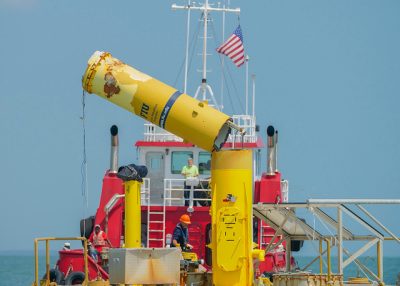The FIU Aquarius Reef Base has been sidelined by Hurricane Irma, but the world’s only underwater research laboratory should be back in operation by the spring of 2018.

The Aquarius habitat sits off the coast of Key Largo, 60 feet deep on the ocean floor. When Hurricane Irma marched across the Caribbean toward the Florida Keys in October, the storm passed over Aquarius ripping the lab’s 94,000-pound life support buoy from its moorings and causing damage to the underwater facilities. Initial estimates put repair costs around $500,000.
“Our schedule for 2018 is filling up fast with research, training and outreach missions being planned so we are working hard to get Aquarius back in operation as quickly as possible,” said James Fourqurean, a marine scientist at FIU and director of the university’s Marine Education and Research Initiative which houses Aquarius. “These missions can’t be moved to another location because there is no other Aquarius, no other underwater research lab anywhere in the world. We have already started receiving donations through a grassroots campaign that is helping greatly, so we’re off to a good start.”
As for the buoy, the storm blew it away from Aquarius, and it eventually came to a rest along the Lignum Vitae Channel, about 14 miles from the habitat. The attached mooring line helped bring it to a stop and it eventually floated under a bridge, which is where the Aquarius team found it. The buoy suffered significant structural damage and has been towed to a South Florida shipyard for repairs.The wet porch, which serves as the entry point into the habitat, took on excess water and life support systems sustained damage, according to Roger Garcia, operations director of Aquarius. On the exterior, decking, air supply hoses, cabling and other support systems were damaged. Structurally, one of the legs on the four-leg platform that the habitat sits on was damaged and will take some time to repair.
The good news, according to Fourqurean, is that the habitat stayed in place and the interior living quarters remained dry.
FIU took over Aquarius from the National Oceanic and Atmospheric Administration in 2013 and formed the Medina Aquarius Program, a research and community outreach program. The facility allows scientists to live and work underwater for extended periods of time. In addition to FIU research being conducted there on coral reef conservation, predator/prey behaviors and seagrasses, Aquarius also offers unique training opportunities for NASA astronauts and others.
“Aquarius gives us the gift of time, meaning researchers can conduct critical research there in a week’s time that would take months or years to do if relying on traditional dives,” said Mike Heithaus, a marine scientist and dean of the FIU College of Arts, Sciences & Education. “Because we can broadcast live from
under the ocean we can also interact with and inspire the next generation.”
Since assuming operations, nearly five years ago, FIU has hosted 19 research and training missions at Aquarius. Recently, FIU and the Coral Restoration Foundation established the world’s deepest coral nursery there to study possible solutions for the rampant loss of coral reefs worldwide. Throughout it all, FIU has also hosted virtual field trips for hundreds of schools worldwide, giving nearly 34,000 schoolchildren the chance to see the habitat up close and interact with aquanauts residing there.
